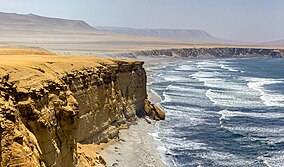Paracas National Reserve
| Paracas National Reserve | |
|---|---|
| Reserva Nacional de Paracas | |
IUCN category VI (protected area with sustainable use of natural resources) | |
 Supay beach, at Paracas National Reserve. | |
| Location | Ica |
| Nearest city | Pisco |
| Coordinates | 13°53′43.5″S 76°16′15.9″W / 13.895417°S 76.271083°W |
| Area | 3350 km² |
| Established | 25 September 1975 |
| Governing body | SERNANP |
| Website | Reserva Nacional de Paracas (in Spanish) |
| Official name | Paracas |
| Designated | 30 March 1992 |
| Reference no. | 545[1] |
Paracas National Reserve is a protected area in the region of Ica, Peru and protects desert and marine ecosystems for their conservation and sustainable use.[2] There are also archaeological remains of the Paracas culture inside the reserve.[2]
Geography
[edit]The reserve is located in the region of Ica, 250 km south of Lima, and a few kilometres from the town of Pisco.[2] It spans an area of 335,000 hectares, 65% of which correspond to marine ecosystems.[3] The highest elevation in the reserve is 786 m.[3]
The reserve includes coastal geographic features such as: the Paracas Peninsula, Independencia Bay, San Gallán Island, Paracas Bay and Independencia Island.[4]
Climate
[edit]| Pisco | ||||||||||||||||||||||||||||||||||||||||||||||||||||||||||||
|---|---|---|---|---|---|---|---|---|---|---|---|---|---|---|---|---|---|---|---|---|---|---|---|---|---|---|---|---|---|---|---|---|---|---|---|---|---|---|---|---|---|---|---|---|---|---|---|---|---|---|---|---|---|---|---|---|---|---|---|---|
| Climate chart (explanation) | ||||||||||||||||||||||||||||||||||||||||||||||||||||||||||||
| ||||||||||||||||||||||||||||||||||||||||||||||||||||||||||||
| ||||||||||||||||||||||||||||||||||||||||||||||||||||||||||||
Paracas National Reserve is an arid zone, with intense local winds known as paracas.[2] Precipitation is scarce and occurs in winter, falling mostly on the top of the highest hills, which is vital to the lomas ecosystem.[2][5] The following climograph corresponds to the nearby town of Pisco (19 m of elevation).[6]
Ecology
[edit]Flora
[edit]Some terrestrial plant species found in the reserve are: Tiquilia paronychoides, Prosopis pallida, Distichlis spicata, Tillandsia spp., Eriosyce omasensis, Geoffroea decorticans, Sesuvium portulacastrum, Cressa truxillensis, Geranium limae, Suaeda foliosa and Oxalis carnosa.[7][8][5][4]
Marine algae found in the reserve include: Ulva lactuca, Chondracanthus chamissoi, Macrocystis pyrifera and Pyropia columbina.[7][9][10]
Fauna
[edit]The Paracas National Reserve houses a great biological diversity, especially in the marine-coastal part. It is estimated that there are about 216 species of birds, 36 of mammals, 10 of reptiles, 168 of fish and a large number of invertebrates that are an initial part of the trophic chain of this important place.
Mammals found in the reserve include: the sei whale, South American fur seal, dusky dolphin, marine otter, sperm whale, humpback whale, South American sea lion, killer whale, common bottlenose dolphin and southern right whale.[2][4]
Birds found in the reserve include: the Andean condor, Chilean flamingo, spotted sandpiper, oasis hummingbird, Peruvian pelican, Inca tern, black skimmer, Humboldt penguin, guanay cormorant, Peruvian thick-knee, Andean swift and Peruvian diving petrel.[7][4] The reserve has been designated an Important Bird Area (IBA) by BirdLife International because it supports significant populations of several bird species.[11]
Molluscs found in the area include: Argopecten purpuratus, Concholepas concholepas, Thais chocolata, Fissurella maxima, Glaucus atlanticus, Choromytilus chorus and Aulacomya atra.[4]
Fish found in the reserve include: Peruvian hake, flathead grey mullet, skipjack tuna, blue flyingfish, humpback smooth-hound, copper shark, Peruvian anchoveta, eastern Pacific bonito, Peruvian eagle ray, fine flounder, blue shark, corvina and bigeye tuna.[4]
Archaeology
[edit]There are more than 100 archaeological sites identified inside the reserve, many of them of the Paracas culture, known especially for their textile crafts.[2]
Recreation
[edit]Beach tourism and wildlife observation are the main activities in the reserve.[2]

Gallery
[edit]-
La Catedral, January 2007
-
La Catedral, November 2000
-
A November 2000 view from within what used to be the Cathedral cave, which was destroyed in earthquake of 2007
-
The red beach in Paracas National Reserve
See also
[edit]
References
[edit]- ^ "Paracas". Ramsar Sites Information Service. Retrieved 25 April 2018.
- ^ a b c d e f g h "De Paracas - Servicio Nacional de Áreas Naturales Protegidas por el Estado". www.sernanp.gob.pe (in European Spanish). Retrieved 2018-11-09.
- ^ a b "Paracas National Reserve - Park Profile - Geography". www.parkswatch.org. Retrieved 2018-11-11.
- ^ a b c d e f Plan Maestro - Reserva Nacional de Paracas 2003-2007 (in Spanish). SERNANP. 2002. pp. 43, 164–165, 179–180.
- ^ a b Johnston, Ivan M. (1931). "The Vascular Flora of the Guano Islands of Peru". Contributions from the Gray Herbarium of Harvard University (95): 26–35. doi:10.5962/p.336136. JSTOR 41764132. S2CID 249076017.
- ^ "Pisco climate: Average Temperature, weather by month, Pisco weather averages - Climate-Data.org". en.climate-data.org. Retrieved 2018-11-10.
- ^ a b c "Paracas National Reserve - Park Profile - Biodiversity". www.parkswatch.org. Retrieved 2018-11-10.
- ^ Paracas National Reserve: 40 years (in Spanish and English). SERNANP. 2015. p. 111.
- ^ Ramírez, M. E.; Santelices, B. (1991). "Catalogo de las algas marinas bentonicas de la costa temperada del Pacifico de Sudamerica". Monografias Biologicas (in Spanish). 5: 1–437.
- ^ "Pyropia columbina (Montagne) W.A.Nelson :: Algaebase". www.algaebase.org. Retrieved 2018-11-10.
- ^ "Reserva Nacional de Paracas". BirdLife Data Zone. BirdLife International. 2024. Retrieved 2024-10-02.





